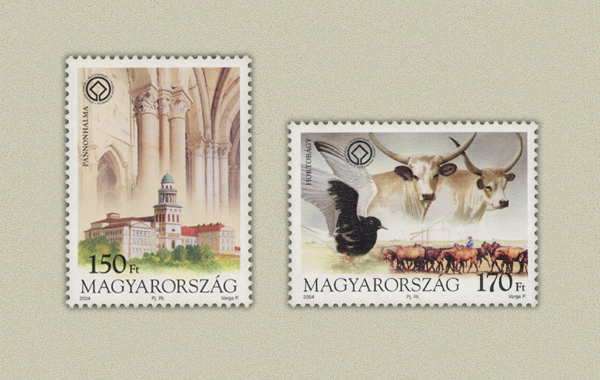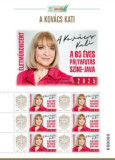
1. MAGYAR - VILÁGÖRÖKSÉGEK MAGYARORSZÁGON II. - Bélyeg rendelési kód: 2004 év bélyegei kompletten
2. ENGLISH - WORLD HERITAGES IN HUNGARY II. - Order code of the stamp: 2004 Year stamps complete
3. GERMAN - Welterbe in Ungarn II. - Die Bestellnummer Der Marke: 2004 Jahr Briefmarken komplett
1. MAGYAR - VILÁGÖRÖKSÉGEK MAGYARORSZÁGON II.
A Magyar Posta Rt. a Pannonhalmi apátság és a Hortobágy bemutatásával folytatja a magyarországi világörökségek bélyegképen történő megörökítését.
Minden nemzet számára fontos feladat saját kultúrájának, történelmének, hagyományainak gondozása, átörökítése és továbbadása az új generációnak. Ez az az örökség, melynek megismerése elengedhetetlen ahhoz, hogy megértsük a jelent és tervezhessük a jövőt. A helyi jelentőségű kulturális és természeti értékek mellett vannak olyanok, amelyek az egész emberiség számára fontosak.
Ezeknek a kiemelt jelentőségű értékeknek a megóvásáról, változatlan formában történő megőrzéséről határozott az ENSZ Oktatási, Tudományos és Kulturális Szervezete (UNESCO) 1972-ben, amikor létrehozták a Világörökség Bizottságot és elfogadták az „Egyezményt a világ kulturális és természeti örökségének védelméről.”
Az egykori Pannónia provincia adta annak a hegynek a nevét (mons Pannonia), amelyen a Szent Márton nevét viselő monostor épült. A bencés apátságot Géza fejedelem alapította 996-ban. Fia Szent István a második évezred kezdetén látta el birtokokkal és kiváltságokkal. Az első épületek az idők során elpusztultak, de ezeken az alapokon újult meg többször is a templom és a monostor.
A Hortobágy Európa legnagyobb összefüggő, természetes füves pusztája, vagyis nem az erdők kiirtása és a folyószabályozás eredményeként jött létre. Az 1973-ban létrehozott első magyar nemzeti park az ország legnagyobb védett területe (82 ezer hektár). Jelentős része Bioszféra Rezervátum, egynegyede pedig a vizes élőhelyek védelméről szóló Ramsari Egyezmény alapján nemzetközi védettséget is élvez.
A 150 Ft-os bélyegképen a pannonhalmi apátság látképe és a templom belső terének gótikus stílusú részlete található. A 170 Ft-os bélyegképen a Hortobágy látképe és jellegzetes hortobágyi motívumok láthatók: ménes, fehérszárnyú szerkő, magyar szürkemarha és gémeskút. A bélyegsorozat egyes címleteihez – az adott terület látképét bemutató –alkalmi boríték készült. Az alkalmi bélyegző grafikáján mindkét tájegység hangulatát idéző grafikai kompozíció látható.
Megjelenési időpont: 2004. március 18.
Forrás: Philatelia Hungarica Kft., Magyar Posta
2. ENGLISH - WORLD HERITAGES IN HUNGARY II.
The Hungarian Post in Pannonhalma and continued with the presentation of the Hungarian Hortobágy Heritage stamp of immortalization.
Every nation is an important task for its own culture, history and traditions of care, átörökítése and transfer to the new generation. This is the heritage of which knowledge is essential to understand the present and target the future. A local cultural and natural values are those which are important for the whole of humanity.
These priority to conservation values, unchanged for the preservation of strong United Nations Educational, Scientific and Cultural Organization (UNESCO) in 1972, which established the World Heritage Committee, and adopted the "Convention on the Protection of World Cultural and Natural Heritage."
In the former province of Pannonia was the name of the mountain (Mons Pannonia), in which the monastery was built bearing the name of St. Martin. The Benedictine abbey was founded by Prince Géza in 996. St. Stephen the son of the second millennium saw the beginning of your estates and privileges. The first buildings were destroyed over time, but these funds renewed several times, the church and the monastery.
Hortobágy is the largest in Europe related to the natural grassland, that is not the result of deforestation and the river was established. In 1973, established the first Hungarian national park in the country's largest protected area (82 thousand hectares). Significant part of the Biosphere Reserve, and one-quarter of the Ramsar Convention on wetlands protection under international protection can enjoy.
The 150 HUF Pannonhalma view of the stamp and the Gothic-style church interior in detail. The HUF 170 stamp and a typical view of the Hortobágy Hortobágy motifs are shown: stud, White-winged Tern, Hungarian and gray shadoof. The stamps of each denomination - the landscape of the area showing the occasional envelope-made. Region both the occasional stamp graphics atmosphere composition shown in the graphic.
3. GERMAN - Welterbe in Ungarn II.
Die Ungarische Post in Pannonhalma und setzte mit der Präsentation der ungarischen Hortobágy Heritage Stempel der Verewigung.
Jede Nation ist eine wichtige Aufgabe für die eigene Kultur, Geschichte und Traditionen der Pflege, átörökítése und den Transfer zu der neuen Generation. Das ist das Erbe von dem Wissen ist unerlässlich für die Gegenwart zu verstehen und Ziel der Zukunft. Eine lokale kulturelle und natürliche Werte sind diejenigen, die für die ganze Menschheit von Bedeutung sind.
Diese Priorität für die Erhaltung Werte unverändert für die Erhaltung der starken United Nations Educational, Scientific and Cultural Organization (UNESCO) in 1972, in dem der Weltkulturerbe-Komitee gegründet, und nahm das "Übereinkommen über den Schutz des Weltkultur-und Naturerbes."
In der ehemaligen Provinz Pannonia war der Name des Berges (Mons Pannonia), in dem das Kloster gebaut wurde, das den Namen St. Martin. Die Benediktiner-Abtei wurde von Fürst Géza im Jahr 996 gegründet. St. Stephan, der Sohn des zweiten Jahrtausends begann die Ihre Güter und Privilegien. Die ersten Gebäude wurden im Laufe der Zeit zerstört, aber diese Mittel wieder mehrere Male, die Kirche und das Kloster.
Hortobágy ist die größte in Europa, um die natürliche Grünland bezogen, das ist nicht das Ergebnis der Entwaldung und der Fluss gegründet wurde. Im Jahr 1973 wurde die erste ungarische Nationalpark in größte Naturschutzgebiet des Landes (82 Tausend Hektar). Bedeutenden Teil des Biosphären-Reservat, und ein Viertel der Ramsar-Konvention zum Schutz unter internationalen Schutz genießen können.
Die 150 HUF Pannonhalma Blick auf den Stempel und die Gothic-Stil Kirchenraum im Detail. Die 170 HUF Stempel und eine typische Ansicht der Hortobágy Hortobágy Motive werden gezeigt: Gestüt, White-winged Tern, Ungarisch und grau shadoof. Die Marken der jeweiligen Bezeichnung - die Landschaft der Umgebung zeigt den gelegentlichen Umschlag-made. Region sowohl die gelegentliche Stempel Grafiken Atmosphäre Zusammensetzung wie in der Grafik.










